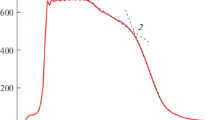Abstract
The velocities of elastic relief waves in commercial aluminum (AD1) and aluminum alloy (D16) samples compressed by a shock wave were measured by the most direct method. Using these results together with the relationship for the three-dimensional velocity of sound as a function of the intensity of the sound wave (derived on the assumption that the shock adiabat and the one-dimensional release isentrope coincide when expressed in pressure/mass-velocity coordinates), Young's modulus, the shear modulus, and the Poisson coefficient are calculated for shock-compressed aluminum.
Similar content being viewed by others
Literature cited
L. V. Al'tshuler, S. B. Kormer, M. I. Brazhnik, L. A. Vladimirov, M. P. Speranskaya, and A. I. Funtikov, “Isentropic compressibility of aluminum, copper, lead, and iron at high pressures,” Zh. Éksp. Teor. Fiz.,38, No. 4, 1061 (1960).
R. Fowles and R. F. Williams, “Plane-stress wave propagation in solids,” J. Appl. Phys.,41, No. 1, 360 (1970).
M. Cowperthwaite and R. F. Williams, “Determination of constitutive relationships with multiple gauges in nondivergent waves,” J. Appl. Phys.,42, No. 1, 456 (1971).
D. R. Curran, “Nonhydrodynamic attenuation of shock waves in aluminum,” J. Appl. Phys.,34, No. 9, 2677 (1963).
J. O. Erkman and A. B. Christensen, “Attenuation of shock waves in aluminum,” J. Appl. Phys.,38, No. 13, 5395 (1967).
A. S. Kusubov and M. van Thiel, “Dynamic yield strength of 2024-T4 aluminum at 313 kbar,” J. Appl. Phys.,40, No. 2, 893 (1969).
A. R. McMillan, “Shock wave attenuation at high pressure,” Bull. Amer. Phys. Soc.,13, No. 12, 1680 (1968).
S. A. Novikov and L. M. Sinitsina, “Influence of the pressure of shock compression on critical shear stresses in metals,” Zh. Prikl. Mekhan. Tekh. Fiz., No. 6 (1970).
L. V. Al'tshuler, M. I. Brazhnik, and G. S. Telegin, “Strength and elasticity of iron and copper at high pressures of shock compression,” Zh. Prikl. Mekhan. Tekh. Fiz., No. 6, 159 (1971).
P. J. A. Fuller and J. H. Price, “Dynamic stress-strain release paths for aluminum and magnesium measured to 200 kbar,” Brit. J. Appl. Phys. (J. Phys. D), Ser. 2,2, No. 2 (1969).
A. S. Kusubov and M. van Thiel, “Measurement of elastic and plastic unloading wave profiles in 2024-T4 aluminum alloy,” J. Appl. Phys.,40, No. 9, 3776 (1969).
P. J. A. Fuller and J. H. Price, “Dynamic pressure measurements to 300 kbar with a resistance transducer,” Brit. J. Appl. Phys.,15, No. 6, 751 (1964).
B. D. Khristoforov, E. É. Goller, A. Ya. Sidorin, and L. D. Livshits, “Manganin sensor for measuring the pressure of shock waves in solids,” Fiz. Goreniya i Vzryva,7, No. 4, 613 (1971).
A. N. Dremin and G. I. Kanel', “Pressure dependence of the electrical resistance of Manganin MNMts and Constantan MNMts 40-1.5 on shock loading,” Fiz. Goreniya i Vzryva,8, No. 1, 147 (1972).
Compendium of Shock-Wave Data, Vol. 1, Ser. A-1, University of California (1970).
F. F. Voronov and L. F. Vereshchagin, “Influence of hydrostatic pressure on the elastic properties of metals. I. Experimental data,” Fiz. Metal. i Metalloved.,11, No. 3 (1961).
R. E. Schmunk and C. S. Smith, “Pressure derivatives of the elastic constants of aluminum and magnesium,” J. Phys. Chem. Solids,9, No. 2, 100–112 (1959).
J. Vallin, M. Mongy, K. Salama, and O. Beckmann, “Elastic constants of aluminum,” J. Appl. Phys.,35, No. 6, 1825 (1964).
G. N. Kamm and G. A. Alers, “Low-temperature elastic moduli of aluminum,” J. Appl. Phys.,35, No. 2, 327 (1964).
L. V. Al'tshuler, S. B. Kormer, A. A. Bakanova, and R. F. Trunin, “Equations of state of aluminum, copper, and lead in the high-pressure region,” Zh. Éksp. Teor. Fiz.,38, No. 3, 790 (1960).
L. V. Al'tshuler, “Use of elastic waves in high-pressure physics,” Usp. Fiz. Nauk,85, No. 2, 197 (1965).
A. N. Dremin and G. I. Kanel', “Refraction of the leading edge of an oblique shock wave at the boundary with a less rigid medium,” Zh. Prikl. Mekhan. Tekh. Fiz., No. 3, 140 (1970).
D. J. Pastine and D. J. O'Keefe, “Theoretical estimates of elastic relief-wave velocities with applications to aluminum and copper,” J. Appl. Phys.,41, No. 6, 2743 (1970).
Author information
Authors and Affiliations
Additional information
Translated from Zhurnal Prikladnoi Mekhaniki i Tekhnicheskoi Fiziki, No. 5, pp. 94–100, September–October, 1974.
The authors wish to thank S. S. Nabatov and V. V. Yakushev, who presented their own design of powder gun, and V. A. Varnav for help in the measurements.
Rights and permissions
About this article
Cite this article
Vorob'ev, A.A., Dremin, A.N. & Kanel', G.I. Elastic coefficients of aluminum as functions of the degree of compression in a shock wave. J Appl Mech Tech Phys 15, 661–665 (1974). https://doi.org/10.1007/BF00851526
Received:
Issue Date:
DOI: https://doi.org/10.1007/BF00851526




